Recent Progress in MEMS Fiber-Optic Fabry–Perot Pressure Sensors
Abstract
:1. Introduction
2. The Principles of MEMS Fiber-Optic FP Pressure Sensors
3. Different Materials of MEMS FP Pressure Sensor Diaphragms
- Dielectric films such as silica, silicon, sapphire, silicon carbide (SiC), etc.;
- Non-dielectric membranes, including metallic membranes, e.g., silver, gold; polymers, e.g., polydimethylsiloxane (PDMS), polyvinyl chloride (PVC), etc.; and two-dimensional material (2D) materials, e.g., graphene, molybdenum disulfide (MoS2), etc.
3.1. Dielectric Diaphragm
3.1.1. Silica Diaphragm

3.1.2. Silicon Diaphragm
3.1.3. Sapphire Diaphragm
3.1.4. SiC, Diamond, and Ceramic Diaphragm
3.2. Non-Dielectric Diaphram
3.2.1. Metal Diaphragm
3.2.2. Polymer Diaphragm
3.2.3. 2D Material Diaphragm
3.3. Advantages of Different Diaphragm Materials
4. Sensor Applications
4.1. Aerodynamic Measurement
4.2. Nuclear Power Plants
4.3. Underwater Application
4.4. Medicine and Healthcare
5. Discussion
6. Conclusions
7. Future Directions
- The fabrication and bonding of diaphragms: further development of processing and bonding technologies is needed to meet the requirements of small-size, high-volume device fabrication for devices of different materials and device specifications.
- Packaging for harsh environments: for future applications, package technology needs to be further developed to meet the harsh scenario requirements and to ensure the long-term stability operation of the devices. When using glue for device encapsulation, the effect of glue and other materials on device performance also needs to be considered.
- Cross-error compensation: it is necessary to further study the mechanism of temperature, strain, bend, and other environmental parameters on the accuracy of the device, and to use appropriate methods to eliminate these errors and improve the overall accuracy of the device.
- The development of more device materials to meet different application requirements.
- Further development of interrogate technology, e.g., improving demodulation speeds, increasing multiplexing capabilities, and finally lowering the cost of the instruments.
Author Contributions
Funding
Conflicts of Interest
References
- Xu, Z.; Wu, D.; Chen, Z.; Wang, Z.; Cao, C.; Shao, X.; Zhou, G.; Zhang, S.; Wang, L.; Sun, D. A Flexible Pressure Sensor with Highly Customizable Sensitivity and Linearity via Positive Design of Microhierarchical Structures with a Hyperelastic Model. Microsyst. Nanoeng. 2023, 9, 5. [Google Scholar] [CrossRef]
- Sundaram, S.; Kellnhofer, P.; Li, Y.; Zhu, J.-Y.; Torralba, A.; Matusik, W. Learning the Signatures of the Human Grasp Using a Scalable Tactile Glove. Nature 2019, 569, 698–702. [Google Scholar] [CrossRef]
- Wang, C.; Hwang, D.; Yu, Z.; Takei, K.; Park, J.; Chen, T.; Ma, B.; Javey, A. User-Interactive Electronic Skin for Instantaneous Pressure Visualization. Nat. Mater. 2013, 12, 899–904. [Google Scholar] [CrossRef]
- Cheng, W.; Wang, X.; Xiong, Z.; Liu, J.; Liu, Z.; Jin, Y.; Yao, H.; Wong, T.-S.; Ho, J.S.; Tee, B.C.K. Frictionless Multiphasic Interface for Near-Ideal Aero-Elastic Pressure Sensing. Nat. Mater. 2023, 22, 1352–1360. [Google Scholar] [CrossRef]
- Schwerter, M.; Grabner, D.; Hecht, L.; Vierheller, A.; Leester-Schadel, M.; Dietzel, A. Surface-Passive Pressure Sensor by Femtosecond Laser Glass Structuring for Flip-Chip-in-Foil Integration. J. Microelectromechanical Syst. 2016, 25, 517–523. [Google Scholar] [CrossRef]
- Haus, J.N.; Schwerter, M.; Schneider, M.; Gäding, M.; Leester-Schädel, M.; Schmid, U.; Dietzel, A. Robust Pressure Sensor in SOI Technology with Butterfly Wiring for Airfoil Integration. Sensors 2021, 21, 6140. [Google Scholar] [CrossRef]
- Kurtz, D.A.D.; Ned, A.A.; Goodman, S.; Epstein, P.A.H. Latest Ruggedized High Temperature Piezoresistive Transducers. In Proceedings of the NASA 2003 Propulsion Measurement Sensor Development Workshop, Huntsville, AL, USA, 13–15 May 2003. [Google Scholar]
- Gossweiler, C.R.; Kupferschmied, P.; Gyarmathy, G. On Fast-Response Probes: Part 1—Technology, Calibration, and Application to Turbomachinery. J. Turbomach. 1995, 117, 611–617. [Google Scholar] [CrossRef]
- Yi, Z.; Zhang, W.; Yang, B. Piezoelectric Approaches for Wearable Continuous Blood Pressure Monitoring: A Review. J. Micromech. Microeng. 2022, 32, 103003. [Google Scholar] [CrossRef]
- Wang, X.; Yu, J.; Cui, Y.; Li, W. Research Progress of Flexible Wearable Pressure Sensors. Sens. Actuators A Phys. 2021, 330, 112838. [Google Scholar] [CrossRef]
- Su, M.; Li, P.; Liu, X.; Wei, D.; Yang, J. Textile-Based Flexible Capacitive Pressure Sensors: A Review. Nanomaterials 2022, 12, 1495. [Google Scholar] [CrossRef]
- Ramanathan, A.K.; Headings, L.M.; Dapino, M.J. Airfoil Anemometer with Integrated Flexible Piezo-Capacitive Pressure Sensor. Front. Mater. 2022, 9, 904056. [Google Scholar] [CrossRef]
- Guardato, S.; Riccio, R.; Janneh, M.; Bruno, F.A.; Pisco, M.; Cusano, A.; Iannaccone, G. An Innovative Fiber-Optic Hydrophone for Seismology: Testing Detection Capacity for Very Low-Energy Earthquakes. Sensors 2023, 23, 3374. [Google Scholar] [CrossRef]
- Cutolo, A.; Bernini, R.; Berruti, G.M.; Breglio, G.; Bruno, F.A.; Buontempo, S.; Catalano, E.; Consales, M.; Coscetta, A.; Cusano, A.; et al. Innovative Photonic Sensors for Safety and Security, Part II: Aerospace and Submarine Applications. Sensors 2023, 23, 2417. [Google Scholar] [CrossRef]
- Zhong, X.; Wang, Y.; Liao, C.; Liu, S.; Tang, J.; Wang, Q. Temperature-Insensitivity Gas Pressure Sensor Based on Inflated Long Period Fiber Grating Inscribed in Photonic Crystal Fiber. Opt. Lett. 2015, 40, 1791. [Google Scholar] [CrossRef]
- Qi, T.; Jung, Y.; Xiao, L.; Wang, J.; Xiao, S.; Lu, C.; Tam, H.; Peacock, A.C. Programmable Long-Period Grating in a Liquid Core Optical Fiber. Opt. Lett. 2016, 41, 4763. [Google Scholar] [CrossRef]
- Zhang, S.; Bae Lee, S.; Fang, X.; Sam Choi, S. In-Fiber Grating Sensors. Opt. Lasers Eng. 1999, 32, 405–418. [Google Scholar] [CrossRef]
- Xu, M.G.; Reekie, L.; Chow, Y.T.; Dakin, J.P. Optical In-Fibre Grating High Pressure Sensor. Electron. Lett. 1993, 29, 398–399. [Google Scholar] [CrossRef]
- He, J.; Wang, Y.; Liao, C.; Wang, C.; Liu, S.; Yang, K.; Wang, Y.; Yuan, X.; Wang, G.P.; Zhang, W. Negative-Index Gratings Formed by Femtosecond Laser Overexposure and Thermal Regeneration. Sci. Rep. 2016, 6, 23379. [Google Scholar] [CrossRef]
- Mihailov, S.J.; Grobnic, D.; Smelser, C.W.; Lu, P.; Walker, R.B.; Ding, H. Bragg Grating Inscription in Various Optical Fibers with Femtosecond Infrared Lasers and a Phase Mask. Opt. Mater. Express 2011, 1, 754. [Google Scholar] [CrossRef]
- Duan, D.-W.; Rao, Y.-J.; Xu, L.-C.; Zhu, T.; Wu, D.; Yao, J. In-Fiber Mach–Zehnder Interferometer Formed by Large Lateral Offset Fusion Splicing for Gases Refractive Index Measurement with High Sensitivity. Sens. Actuators B Chem. 2011, 160, 1198–1202. [Google Scholar] [CrossRef]
- Li, Z.; Liao, C.; Wang, Y.; Xu, L.; Wang, D.; Dong, X.; Liu, S.; Wang, Q.; Yang, K.; Zhou, J. Highly-Sensitive Gas Pressure Sensor Using Twin-Core Fiber Based in-Line Mach-Zehnder Interferometer. Opt. Express 2015, 23, 6673. [Google Scholar] [CrossRef]
- Rodríguez, C.A.; Ribeiro, M.R.N.; Frizera-Neto, A.; Castellani, C.E.S.; Pontes, M.J. Envelope-Based Technique for Liquid Level Sensors Using an in-Line Fiber Mach–Zehnder Interferometer. Appl. Opt. 2016, 55, 9803. [Google Scholar] [CrossRef]
- Shang, X.; Wang, N.; Cao, S.; Chen, H.; Fan, D.; Zhou, N.; Qiu, M. Fiber-integrated Force Sensor Using 3D Printed Spring-Composed Fabry-Perot Cavities with a High Precision Down to Tens of Piconewton. Adv. Mater. 2023, 36, e2305121. [Google Scholar] [CrossRef]
- Shang, C.; Fu, B.; Tuo, J.; Guo, X.; Li, Z.; Wang, Z.; Xu, L.; Guo, J. Soft Biomimetic Fiber-Optic Tactile Sensors Capable of Discriminating Temperature and Pressure. ACS Appl. Mater. Interfaces 2023, 15, 53264–53272. [Google Scholar] [CrossRef]
- Geilen, A.; Popp, A.; Das, D.; Junaid, S.; Poulton, C.G.; Chemnitz, M.; Marquardt, C.; Schmidt, M.A.; Stiller, B. Extreme Thermodynamics in Nanolitre Volumes through Stimulated Brillouin–Mandelstam Scattering. Nat. Phys. 2023, 19, 1805–1812. [Google Scholar] [CrossRef]
- Zhu, Y.; Pickrell, G.; Wang, X.; Xu, J.; Yu, B.; Han, M.; Cooper, K.L.; Wang, A.; Ringshia, A.; Ng, W. Miniature Fiber Optic Pressure Sensor for Turbine Engines; Wang, A., Ed.; SPIE: Philadelphia, PA, USA, 2004; p. 11. [Google Scholar]
- Cai, T.; Tong, X.; Chen, G. Monitoring Intracranial Pressure Based on F-P. In Proceedings of the Fourth Asia Pacific Optical Sensors Conference, Wuhan, China, 15–18 October 2013; SPIE: Bellingham, WA, USA, 2013; p. 89242R. [Google Scholar]
- Di Giovanni, M. Flat and Corrugated Diaphragm Design Handbook, 1st ed.; Routledge: Abingdon, UK, 2017; ISBN 978-0-203-75596-9. [Google Scholar]
- Donlagic, D.; Cibula, E. All-Fiber High-Sensitivity Pressure Sensor with SiO2 Diaphragm. Opt. Lett. 2005, 30, 2071–2073. [Google Scholar] [CrossRef]
- Zhu, Y.; Wang, A. Miniature Fiber-Optic Pressure Sensor. IEEE Photonics Technol. Lett. 2005, 17, 447–449. [Google Scholar] [CrossRef]
- Zhu, Y.; Cooper, K.; Pickrell, G.; Wang, A. High-Temperature Fiber-Tip Pressure Sensor. J. Light. Technol. 2006, 24, 861–869. [Google Scholar] [CrossRef]
- Liao, C.; Liu, S.; Xu, L.; Wang, C.; Wang, Y.; Li, Z.; Wang, Q.; Wang, D.N. Sub-Micron Silica Diaphragm-Based Fiber-Tip Fabry–Perot Interferometer for Pressure Measurement. Opt. Lett. 2014, 39, 2827–2830. [Google Scholar] [CrossRef]
- Liu, S.; Wang, Y.; Liao, C.; Wang, Y.; He, J.; Fu, C.; Yang, K.; Bai, Z.; Zhang, F. Nano Silica Diaphragm In-Fiber Cavity for Gas Pressure Measurement. Sci. Rep. 2017, 7, 787. [Google Scholar] [CrossRef]
- Zhang, H.; Liu, J.; Li, J.; Jia, P.; Feng, F.; Hong, Y.; Shen, S.; Liang, T.; Xiong, J. Miniature All-Silica Microbubble-Based Fiber Optic Fabry-Perot Pressure Sensor with Pressure Leading-In Tube. J. Sens. 2019, 2019, 5704614. [Google Scholar] [CrossRef]
- Zhang, S.; Shao, Z.; Liu, J.; Zong, M.; Shen, J.; Gao, H.; Wang, G.; Huang, M. An Optical Fiber Fabry–Perot Pressure Sensor with Optimized Thin Microbubble Film Shaping for Sensitivity Enhancement. Coatings 2020, 10, 358. [Google Scholar] [CrossRef]
- Wang, W.; Wu, N.; Tian, Y.; Niezrecki, C.; Wang, X. Miniature All-Silica Optical Fiber Pressure Sensor with an Ultrathin Uniform Diaphragm. Opt. Express 2010, 18, 9006. [Google Scholar] [CrossRef]
- Guo, X.; Zhou, J.; Du, C.; Wang, X. Highly Sensitive Miniature All-Silica Fiber Tip Fabry–Perot Pressure Sensor. IEEE Photonics Technol. Lett. 2019, 31, 689–692. [Google Scholar] [CrossRef]
- Zhang, Y.; Yuan, L.; Lan, X.; Kaur, A.; Huang, J.; Xiao, H. High-Temperature Fiber-Optic Fabry–Perot Interferometric Pressure Sensor Fabricated by Femtosecond Laser. Opt. Lett. 2013, 38, 4609–4612. [Google Scholar] [CrossRef] [PubMed]
- Duraibabu, D.B.; Poeggel, S.; Omerdic, E.; Capocci, R.; Lewis, E.; Newe, T.; Leen, G.; Toal, D.; Dooly, G. An Optical Fibre Depth (Pressure) Sensor for Remote Operated Vehicles in Underwater Applications. Sensors 2017, 17, 406. [Google Scholar] [CrossRef] [PubMed]
- Ran, Z.; Rao, Y.; Zhang, J.; Xu, B. Laser-Machined All-Fiber in-Line Tip Pressure Sensor. In Proceedings of the 20th International Conference on Optical Fibre Sensors, Edinburgh, UK, 5 October 2009; IEEE: Piscataway, NJ, USA, 2009; Volume 7503, p. 75032X. [Google Scholar]
- Huang, W.; Zhang, Z.; He, J.; Du, B.; Liao, C.; Liu, S.; Yin, G.; Wang, Y. Nonlinear Hydraulic Pressure Response of an Improved Fiber Tip Interferometric High-Pressure Sensor. Sensors 2020, 20, 2548. [Google Scholar] [CrossRef]
- Li, M.; Wang, M.; Li, H. Optical MEMS Pressure Sensor Based on Fabry-Perot Interferometry. Opt. Express 2006, 14, 1497–1504. [Google Scholar] [CrossRef]
- Yin, J.; Liu, T.; Jiang, J.; Liu, K.; Wang, S.; Qin, Z.; Zou, S. Batch-Producible Fiber-Optic Fabry–Pérot Sensor for Simultaneous Pressure and Temperature Sensing. IEEE Photonics Technol. Lett. 2014, 26, 2070–2073. [Google Scholar] [CrossRef]
- Jia, P.; Liang, H.; Fang, G.; Qian, J.; Feng, F.; Liang, T.; Xiong, J. Batch-Producible MEMS Fiber-Optic Fabry–Perot Pressure Sensor for High-Temperature Application. Appl. Opt. 2018, 57, 6687–6692. [Google Scholar] [CrossRef]
- Wang, X.; Wang, S.; Jiang, J.; Liu, K.; Xiao, M.; Chen, X.; Zhang, D.; Liu, T. An MEMS Optical Fiber Pressure Sensor Fabricated by Au-Au Thermal-Compression Bonding. In Proceedings of the 2017 International Conference on Optical Instruments and Technology: Advanced Optical Sensors and Applications, Beijing, China, 28–30 October 2017; SPIE: Bellingham, WA, USA, 2018; Volume 10618, pp. 122–129. [Google Scholar]
- Jiang, X.; Lin, C.; Huang, Y.; Luo, K.; Zhang, J.; Jiang, Q.; Zhang, C. Hybrid Fiber Optic Sensor, Based on the Fabry–Perot Interference, Assisted with Fluorescent Material for the Simultaneous Measurement of Temperature and Pressure. Sensors 2019, 19, 1097. [Google Scholar] [CrossRef]
- Wang, X.; Jiang, J.; Wang, S.; Liu, K.; Liu, T. All-Silicon Dual-Cavity Fiber-Optic Pressure Sensor with Ultralow Pressure-Temperature Cross-Sensitivity and Wide Working Temperature Range. Photonics Res. 2021, 9, 521. [Google Scholar] [CrossRef]
- Li, J.; Jia, P.; Fang, G.; Wang, J.; Qian, J.; Ren, Q.; Xiong, J. Batch-Producible All-Silica Fiber-Optic Fabry–Perot Pressure Sensor for High-Temperature Applications up to 800 °C. Sens. Actuators A Phys. 2022, 334, 113363. [Google Scholar] [CrossRef]
- Wang, Z.; Chen, J.; Wei, H.; Liu, H.; Ma, Z.; Chen, N.; Chen, Z.; Wang, T.; Pang, F. Sapphire Fabry–Perot Interferometer for High-Temperature Pressure Sensing. Appl. Opt. 2020, 59, 5189–5196. [Google Scholar] [CrossRef]
- Guo, Z.; Lv, W.; Wang, W.; Chen, Q.; Zhang, X.; Chen, H.; Ma, Z. Absolute Single Cavity Length Interrogation of Fiber-Optic Compound Fabry–Perot Pressure Sensors Through a White Light Non-Scanning Correlation Method. Sensors 2019, 19, 1628. [Google Scholar] [CrossRef] [PubMed]
- Li, W.; Liang, T.; Jia, P.; Lei, C.; Hong, Y.; Li, Y.; Yao, Z.; Liu, W.; Xiong, J. Fiber-Optic Fabry–Perot Pressure Sensor Based on Sapphire Direct Bonding for High-Temperature Applications. Appl. Opt. 2019, 58, 1662–1666. [Google Scholar] [CrossRef] [PubMed]
- Shao, Z.; Wu, Y.; Sun, Z.; Wang, W.; Liu, Z.; Zhang, C.; Bi, J.; Song, E. Excellent Repeatability, All-Sapphire Fabry Perot Optical Pressure Sensor Based on Wet Etching and Direct Bonding for Harsh Environment Applications. Opt. Express 2021, 29, 19831–19838. [Google Scholar] [CrossRef] [PubMed]
- Shao, Z.; Wu, Y.; Wang, S.; Wang, Y.; Sun, Z.; Wang, W.; Liu, Z.; Liu, B. All-Sapphire Fiber-Optic Pressure Sensors for Extreme Harsh Environments. Opt. Express 2022, 30, 3665–3674. [Google Scholar] [CrossRef] [PubMed]
- Zhang, Y.; Jiang, Y.; Deng, H.; Gao, H.; Tang, C.; Wang, X. All-Sapphire-Based Optical Fiber Pressure Sensor with an Ultra-Wide Pressure Range Based on Femtosecond Laser Micromachining and Direct Bonding. Opt. Express 2023, 31, 41967–41978. [Google Scholar] [CrossRef] [PubMed]
- Bae, H.; Giri, A.; Kolawole, O.; Azimi, A.; Jackson, A.; Harris, G. Miniature Diamond-Based Fiber Optic Pressure Sensor with Dual Polymer-Ceramic Adhesives. Sensors 2019, 19, 2202. [Google Scholar] [CrossRef]
- Jiang, Y.; Li, J.; Zhou, Z.; Jiang, X.; Zhang, D. Fabrication of All-SiC Fiber-Optic Pressure Sensors for High-Temperature Applications. Sensors 2016, 16, 1660. [Google Scholar] [CrossRef]
- Liang, T.; Li, W.; Lei, C.; Li, Y.; Li, Z.; Xiong, J. All-SiC Fiber-Optic Sensor Based on Direct Wafer Bonding for High Temperature Pressure Sensing. Photonic Sens. 2022, 12, 130–139. [Google Scholar] [CrossRef]
- Liu, J.; Jia, P.; Zhang, H.; Tian, X.; Liang, H.; Hong, Y.; Liang, T.; Liu, W.; Xiong, J. Fiber-Optic Fabry–Perot Pressure Sensor Based on Low-Temperature Co-Fired Ceramic Technology for High-Temperature Applications. Appl. Opt. 2018, 57, 4211. [Google Scholar] [CrossRef]
- Gong, Z.; Chen, K.; Yang, Y.; Zhou, X.; Peng, W.; Yu, Q. High-Sensitivity Fiber-Optic Acoustic Sensor for Photoacoustic Spectroscopy Based Traces Gas Detection. Sens. Actuators B Chem. 2017, 247, 290–295. [Google Scholar] [CrossRef]
- Guo, F.; Fink, T.; Han, M.; Koester, L.; Turner, J.; Huang, J. High-Sensitivity, High-Frequency Extrinsic Fabry–Perot Interferometric Fiber-Tip Sensor Based on a Thin Silver Diaphragm. Opt. Lett. 2012, 37, 1505. [Google Scholar] [CrossRef]
- Xu, F.; Ren, D.; Shi, X.; Li, C.; Lu, W.; Lu, L.; Lu, L.; Yu, B. High-Sensitivity Fabry–Perot Interferometric Pressure Sensor Based on a Nanothick Silver Diaphragm. Opt. Lett. 2012, 37, 133–135. [Google Scholar] [CrossRef] [PubMed]
- Lai, C.-W.; Lo, Y.-L.; Yur, J.-P.; Liu, W.-F.; Chuang, C.-H. Application of Fabry–Pérot and Fiber Bragg Grating Pressure Sensors to Simultaneous Measurement of Liquid Level and Specific Gravity. Measurement 2012, 45, 469–473. [Google Scholar] [CrossRef]
- Bae, H.; Yun, D.; Liu, H.; Olson, D.A.; Yu, M. Hybrid Miniature Fabry–Perot Sensor with Dual Optical Cavities for Simultaneous Pressure and Temperature Measurements. J. Light. Technol. 2014, 32, 1585–1593. [Google Scholar] [CrossRef]
- Eom, J.; Park, C.-J.; Lee, B.H.; Lee, J.-H.; Kwon, I.-B.; Chung, E. Fiber Optic Fabry–Perot Pressure Sensor Based on Lensed Fiber and Polymeric Diaphragm. Sens. Actuators Phys. 2015, 225, 25–32. [Google Scholar] [CrossRef]
- Zhang, Z.; Liao, C.; Tang, J.; Bai, Z.; Guo, K.; Hou, M.; He, J.; Wang, Y.; Liu, S.; Zhang, F.; et al. High-Sensitivity Gas-Pressure Sensor Based on Fiber-Tip PVC Diaphragm Fabry–Pérot Interferometer. J. Light. Technol. 2017, 35, 4067–4071. [Google Scholar] [CrossRef]
- Guggenheim, J.A.; Li, J.; Allen, T.J.; Colchester, R.J.; Noimark, S.; Ogunlade, O.; Parkin, I.P.; Papakonstantinou, I.; Desjardins, A.E.; Zhang, E.Z.; et al. Ultrasensitive Plano-Concave Optical Microresonators for Ultrasound Sensing. Nat. Photonics 2017, 11, 714–719. [Google Scholar] [CrossRef]
- Zhao, Y.; Chen, M.; Xia, F.; Lv, R. Small In-Fiber Fabry-Perot Low-Frequency Acoustic Pressure Sensor with PDMS Diaphragm Embedded in Hollow-Core Fiber. Sens. Actuators A Phys. 2018, 270, 162–169. [Google Scholar] [CrossRef]
- Wei, H.; Chen, M.; Krishnaswamy, S. Three-Dimensional-Printed Fabry–Perot Interferometer on an Optical Fiber Tip for a Gas Pressure Sensor. Appl. Opt. 2020, 59, 2173–2178. [Google Scholar] [CrossRef] [PubMed]
- Ma, J.; Jin, W.; Ho, H.L.; Dai, J.Y. High-Sensitivity Fiber-Tip Pressure Sensor with Graphene Diaphragm. Opt. Lett. 2012, 37, 2493–2495. [Google Scholar] [CrossRef] [PubMed]
- Li, C.; Xiao, J.; Guo, T.; Fan, S.; Jin, W. Interference Characteristics in a Fabry–Perot Cavity with Graphene Membrane for Optical Fiber Pressure Sensors. Microsyst. Technol. 2015, 21, 2297–2306. [Google Scholar] [CrossRef]
- Li, C.; Gao, X.; Guo, T.; Xiao, J.; Fan, S.; Jin, W. Analyzing the Applicability of Miniature Ultra-High Sensitivity Fabry–Perot Acoustic Sensor Using a Nanothick Graphene Diaphragm. Meas. Sci. Technol. 2015, 26, 085101. [Google Scholar] [CrossRef]
- Dong, Q.; Bae, H.; Zhang, Z.; Chen, Y.; Wen, Z.; Olson, D.A.; Yu, M.; Liu, H. Miniature Fiber Optic Acoustic Pressure Sensors with Air-Backed Graphene Diaphragms. J. Vib. Acoust. 2019, 141, 041003. [Google Scholar] [CrossRef]
- Cui, Q.; Thakur, P.; Rablau, C.; Avrutsky, I.; Cheng, M.M.-C. Miniature Optical Fiber Pressure Sensor with Exfoliated Graphene Diaphragm. IEEE Sens. J. 2019, 19, 5621–5631. [Google Scholar] [CrossRef]
- Yu, F.; Liu, Q.; Gan, X.; Hu, M.; Zhang, T.; Li, C.; Kang, F.; Terrones, M.; Lv, R. Ultrasensitive Pressure Detection of Few-Layer MoS2. Adv. Mater. 2017, 29, 1603266. [Google Scholar] [CrossRef]
- Pechstedt, R.D. Fibre Optic Pressure and Temperature Sensor for Applications in Harsh Environments. In Proceedings of the Fifth European Workshop on Optical Fibre Sensors, Krakow, Poland, 19–22 May 2013; SPIE: Bellingham, WA, USA, 2013; Volume 8794, pp. 15–18. [Google Scholar]
- Liu, Y.; Jing, Z.; Liu, Q.; Li, A.; Teng, C.; Cheung, Y.; Lee, A.; Tian, F.; Peng, W. Differential-Pressure Fiber-Optic Airflow Sensor for Wind Tunnel Testing. Opt. Express 2020, 28, 25101. [Google Scholar] [CrossRef]
- Liu, Y.; Jing, Z.; Liu, Q.; Li, A.; Li, W.; Zhang, S.; Lee, A.; Tian, F.; Li, R.; Peng, W. Fiber-Optic Integrated Aerodynamic Three-Hole Vector Probe for High-Velocity Flow Field Measurement. iScience 2022, 25, 104402. [Google Scholar] [CrossRef]
- Huang, P.; Wang, N.; Li, J.; Zhu, Y.; Zhang, J.; Xi, Z. Optical Fiber Demodulation System with High Performance for Assessing Fretting Damage of Steam Generator Tubes. Sensors 2018, 18, 201. [Google Scholar] [CrossRef]
- Poeggel, S.; Tosi, D.; Leen, G.; Lewis, E. Low-Cost Miniature Fiber Optic Extrinsic Fabry-Perot Interferometric Sensor for Cardiovascular Pressure Measurement. In Proceedings of the 2013 Conference on Lasers & Electro-Optics Europe & International Quantum Electronics Conference CLEO EUROPE/IQEC, Munich, Germany, 12–16 May 2013; IEEE: New York, USA, 2013; p. 1–1. [Google Scholar]
- Wu, N.; Tian, Y.; Zou, X.; Zhai, Y.; Barringhaus, K.; Wang, X. A Miniature Fiber Optic Blood Pressure Sensor and Its Application in in Vivo Blood Pressure Measurements of a Swine Model. Sens. Actuators B Chem. 2013, 181, 172–178. [Google Scholar] [CrossRef]
- Poeggel, S.; Tosi, D.; Fusco, F.; Ippolito, J.; Lupoli, L.; Mirone, V.; Sannino, S.; Leen, G.; Lewis, E. Fiber-Optic EFPI Pressure Sensors for In Vivo Urodynamic Analysis. IEEE Sens. J. 2014, 14, 2335–2340. [Google Scholar] [CrossRef]
- Tian, Y.; Wu, N.; Zou, X.; Zhang, Y.; Barringhaus, K.; Wang, X. A Study on Packaging of Miniature Fiber Optic Sensors for In-Vivo Blood Pressure Measurements in a Swine Model. IEEE Sens. J. 2014, 14, 629–635. [Google Scholar] [CrossRef]
- Shin, J.; Liu, Z.; Bai, W.; Liu, Y.; Yan, Y.; Xue, Y.; Kandela, I.; Pezhouh, M.; MacEwan, M.R.; Huang, Y.; et al. Bioresorbable Optical Sensor Systems for Monitoring of Intracranial Pressure and Temperature. Sci. Adv. 2019, 5, eaaw1899. [Google Scholar] [CrossRef] [PubMed]
- Uretsky, B.F.; Agarwal, S.K.; Vallurupalli, S.; Al-Hawwas, M.; Hasan, R.; Miller, K.; Hakeem, A. Prospective Evaluation of the Strategy of Functionally Optimized Coronary Intervention. J. Am. Heart Assoc. 2020, 9, e015073. [Google Scholar] [CrossRef] [PubMed]
- Omori, H.; Kawase, Y.; Hara, M.; Tanigaki, T.; Okamoto, S.; Hirata, T.; Kikuchi, J.; Ota, H.; Sobue, Y.; Miyake, T.; et al. Feasibility and Safety of Jailed-pressure Wire Technique Using Durable Optical Fiber Pressure Wire for Intervention of Coronary Bifurcation Lesions. Catheter. Cardiovasc. Interv. 2019, 94, E61–E66. [Google Scholar] [CrossRef] [PubMed]
- Ulacia, P.; Rimac, G.; Lalancette, S.; Belleville, C.; Mongrain, R.; Plante, S.; Rusza, Z.; Matsuo, H.; Bertrand, O.F. A Novel Fiber-Optic Based 0.014″ Pressure Wire: Designs of the OptoWireTM, Development Phases, and the O2 First-in-Man Results. Catheter. Cardiovasc. Interv. 2022, 99, 59–67. [Google Scholar] [CrossRef] [PubMed]
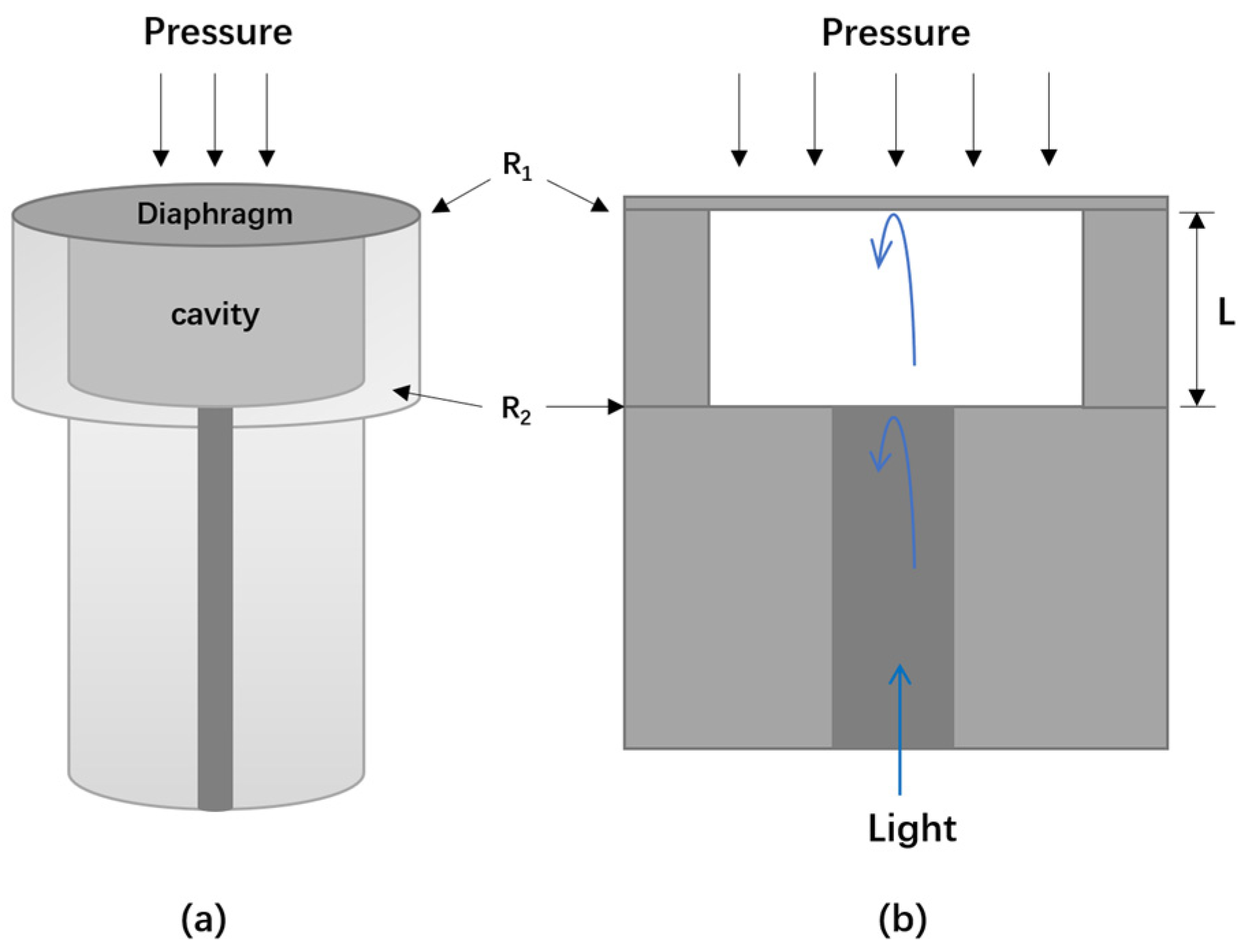




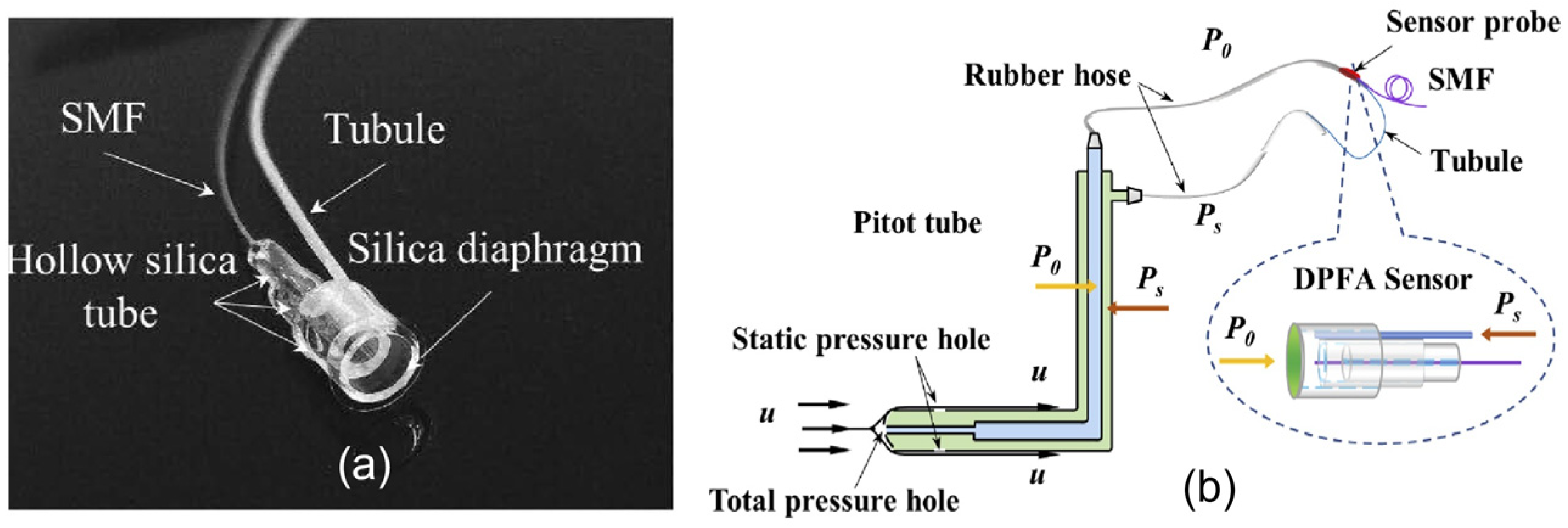
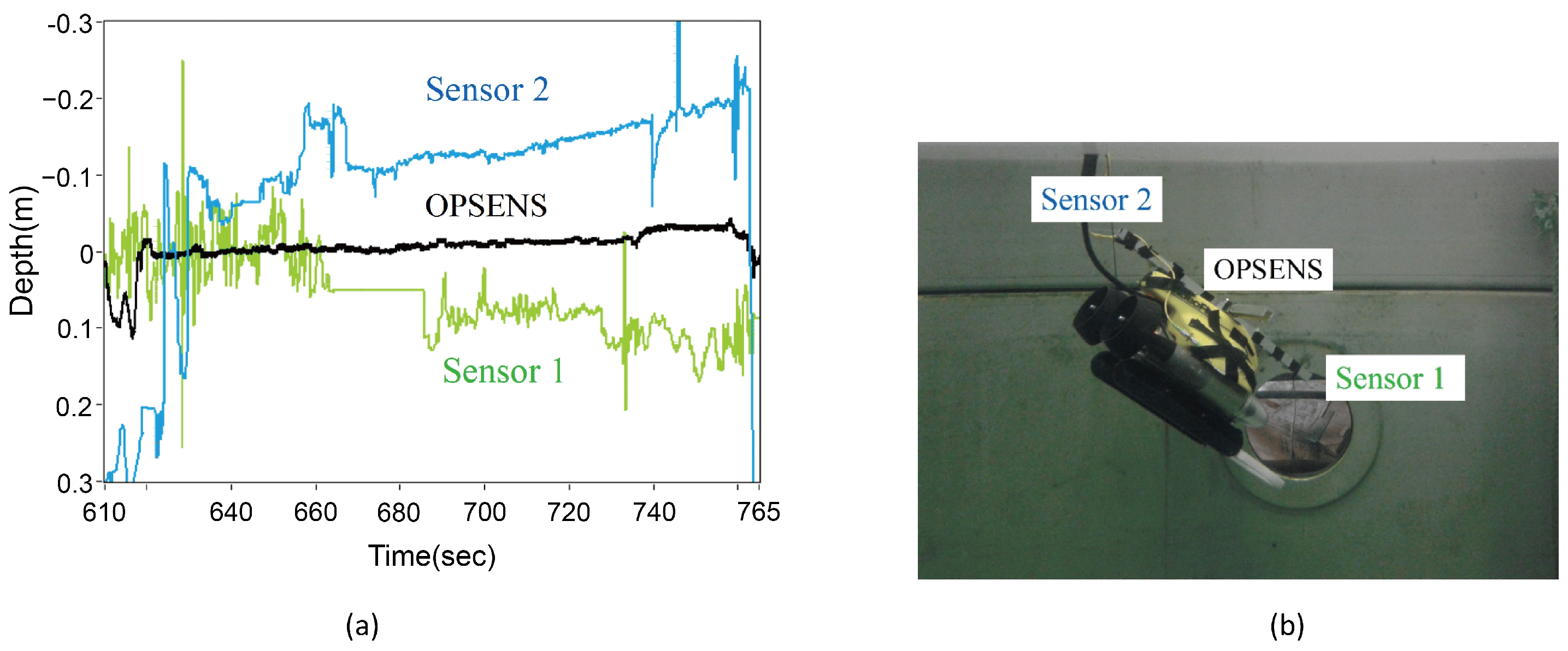
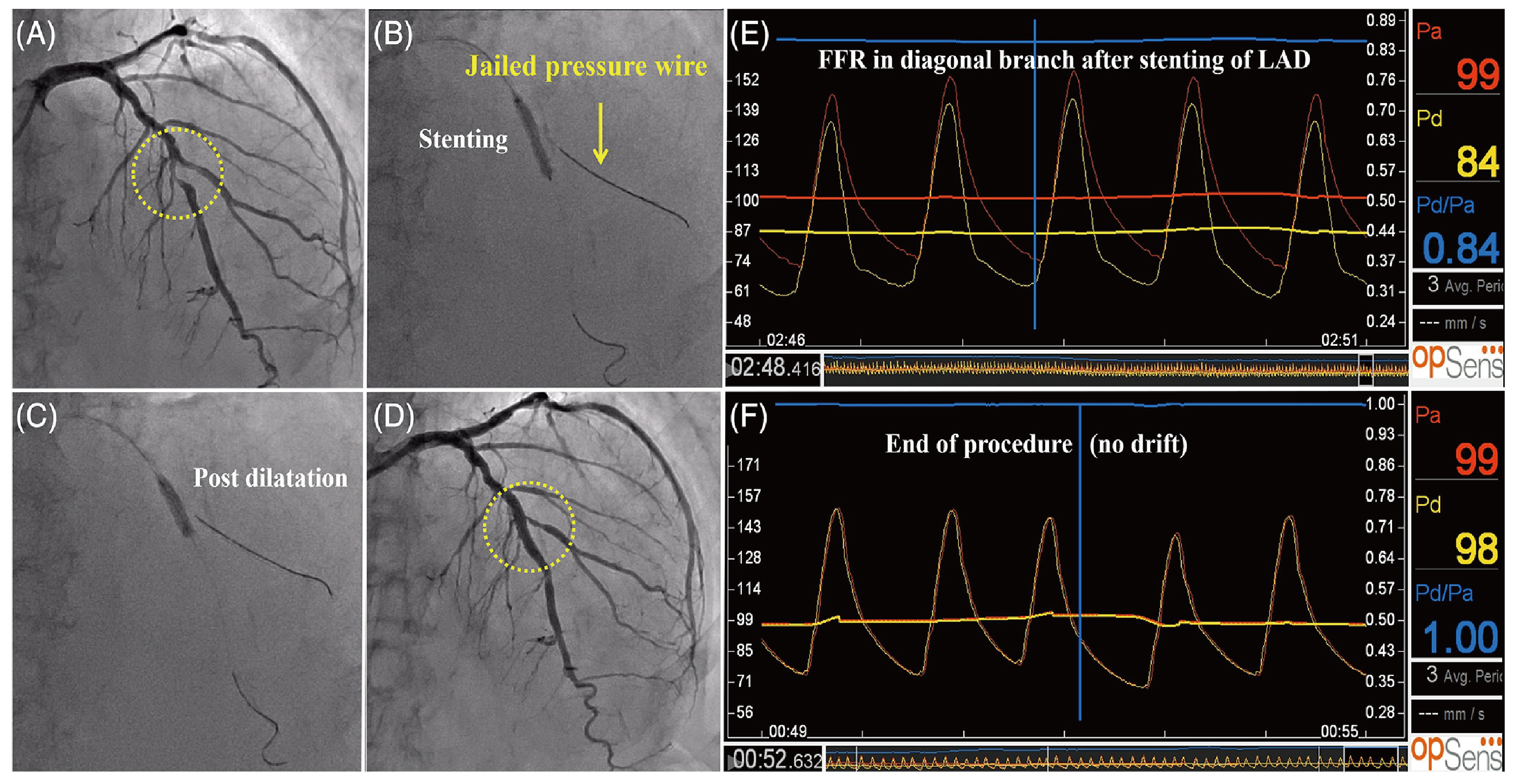
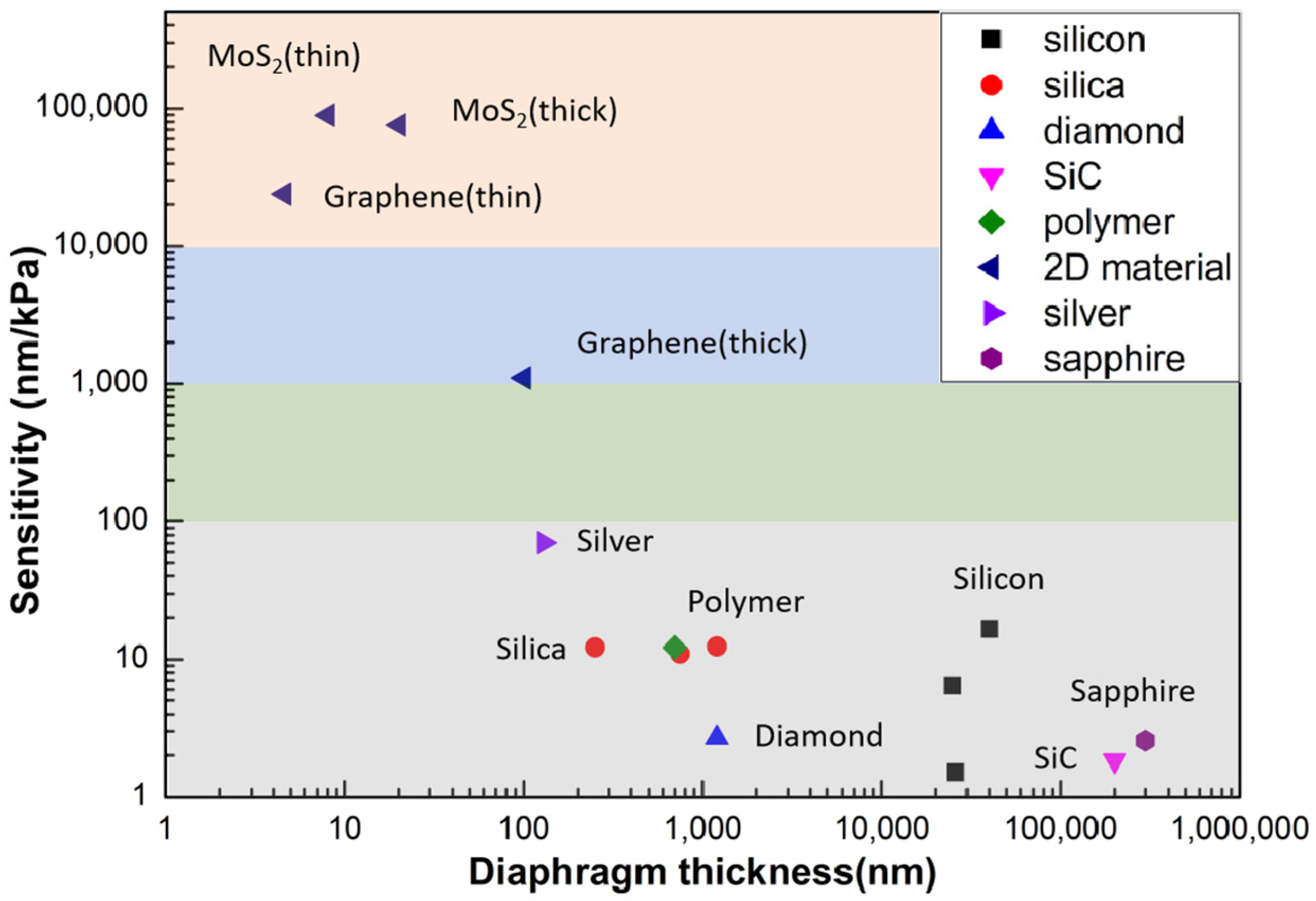
| Diaphragm Material | Diaphragm Thickness | Pressure Sensitivity |
|---|---|---|
| MoS2 | ~8 nm | 89,300 nm/kPa |
| ~20 nm | 75,600 nm/kPa | |
| Graphene | ~4.6 nm | 23,800 nm/kPa |
| ~100 nm | 1100 nm/kPa | |
| Silver film | 130 nm | 70.5 nm/kPa |
| Silica film | ~250 nm | 12.22 nm/kPa |
| ~750 nm | 11 nm/kPa | |
| 1.2 μm | 12.4 nm/kPa | |
| 25 μm | 0.28 nm/kPa | |
| Silicon film | 25 μm | 6.408 nm/kPa |
| 26 μm | 1.526 nm/kPa | |
| 40 μm | 16.517 nm/kPa | |
| Polymer film | ~700 nm | 12.2 nm/kPa |
| Sapphire film | 300 μm | 2.561 nm/kPa |
| SiC film | 200 μm | 1.84 nm/kPa |
| Diamond film | 1.2 μm | 2.683 nm/kPa |
Disclaimer/Publisher’s Note: The statements, opinions and data contained in all publications are solely those of the individual author(s) and contributor(s) and not of MDPI and/or the editor(s). MDPI and/or the editor(s) disclaim responsibility for any injury to people or property resulting from any ideas, methods, instructions or products referred to in the content. |
© 2024 by the authors. Licensee MDPI, Basel, Switzerland. This article is an open access article distributed under the terms and conditions of the Creative Commons Attribution (CC BY) license (https://creativecommons.org/licenses/by/4.0/).
Share and Cite
Chen, Y.; Lu, D.; Xing, H.; Ding, H.; Luo, J.; Liu, H.; Kong, X.; Xu, F. Recent Progress in MEMS Fiber-Optic Fabry–Perot Pressure Sensors. Sensors 2024, 24, 1079. https://doi.org/10.3390/s24041079
Chen Y, Lu D, Xing H, Ding H, Luo J, Liu H, Kong X, Xu F. Recent Progress in MEMS Fiber-Optic Fabry–Perot Pressure Sensors. Sensors. 2024; 24(4):1079. https://doi.org/10.3390/s24041079
Chicago/Turabian StyleChen, Ye, Dongqin Lu, Huan Xing, Haotian Ding, Junxian Luo, Hanwen Liu, Xiangxu Kong, and Fei Xu. 2024. "Recent Progress in MEMS Fiber-Optic Fabry–Perot Pressure Sensors" Sensors 24, no. 4: 1079. https://doi.org/10.3390/s24041079





